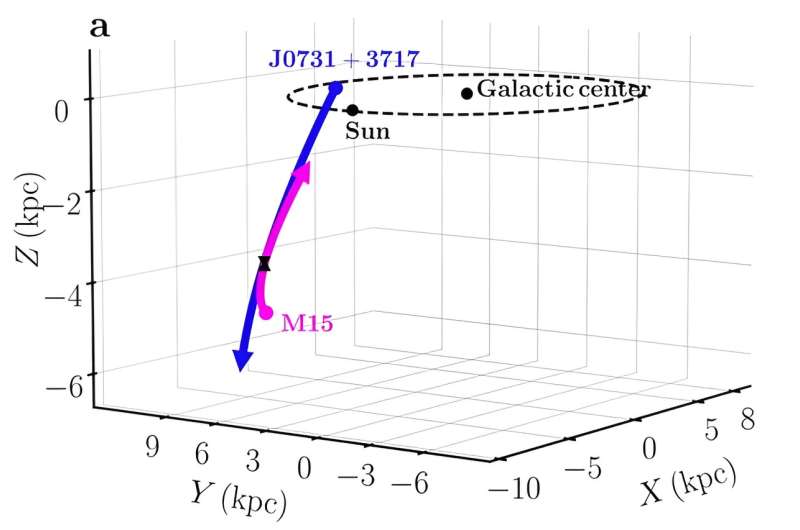June 11, 2024 report
This article has been reviewed according to Science X's editorial process and policies. Editors have highlighted the following attributes while ensuring the content's credibility:
fact-checked
preprint
trusted source
proofread
Chinese astronomers discover a high-velocity star ejected from globular cluster Messier 15

Chinese astronomers report the discovery of a new high-velocity star about 4,200 light years away. The newfound star, designated J0731+3717, turned out to be ejected from the globular cluster Messier 15 by an intermediate-mass black hole. The finding was presented in a paper published June 3 on the pre-print server arXiv.
Globular clusters (GCs) are collections of tightly bound stars orbiting galaxies. Astronomers perceive them as natural laboratories enabling studies on the evolution of stars and galaxies. In particular, globular clusters could help researchers to better understand the formation history and evolution of early-type galaxies, as the origin of GCs seems to be closely linked to periods of intense star formation.
Located some 35,700 light years away from the Earth, Messier 15 (also known as NGC 7078, or M15) is a core-collapsed GC with a radius of about 88 light years and an estimated mass of 560,000 solar masses. It is one of the oldest (about 12.5 billion years old) and most metal-poor Galactic GCs (with a metallicity of approximately −2.25), and one of the most densely packed GCs in our galaxy.
The cluster is known to host an intermediate-mass black hole (IMBH) with an estimated mass of 1,700–3,200 solar masses.
The team of astronomers led by Yang Huang of the University of Chinese Academy of Sciences in Beijing, has recently conducted a search for high-velocity stars that might be ejected from a globular cluster. As a result, by analyzing the data mainly from the Sloan Digital Sky Survey (SDSS) and from ESA's Gaia satellite, they found a promising candidate in Messier 15.
"We report the discovery of a high-velocity star J0731+3717, whose backward trajectory about 21 Myr ago intersects that of globular cluster M15 within the cluster tidal radius," the researchers explained.
J0731+3717 has a total velocity of 418.71 km/s, a mass of about 0.69 solar masses and an effective temperature of 6,062 K. The star, estimated to be 13 billion years old, is located some 4,200 light years away from the Earth and has a metallicity at a level of -2.23.
The study found that while J0731+3717 is currently 37,500 light years away from Messier 15, their backward trajectories intersect with each other 21 million years ago with a relative velocity of 548 km/s and a closest distance of approximately 189 light years. This distance is smaller than the tidal radius of Messier 15, which is estimated to be 430 light years.
Moreover, it turned out that J0731+3717 exhibits rare chemical fingerprints consistent with those of Messier 15, and has a similar metallicity and age to that of the cluster. Therefore, the astronomers concluded that this star is originally associated with Messier 15.
The authors of the paper assume that J0731+3717 was most likely tidally ejected from as close as 1 AU to the center of Messier 15. They added that an ejection with such a high velocity requires a black hole with a mass of at least 100 solar masses, which means that the cluster's IMBH is most likely responsible for it.
More information: Yang Huang et al, A high-velocity star recently ejected by an intermediate-mass black hole in M15, arXiv (2024). DOI: 10.48550/arxiv.2406.00923
Journal information: arXiv
© 2024 Science X Network





















